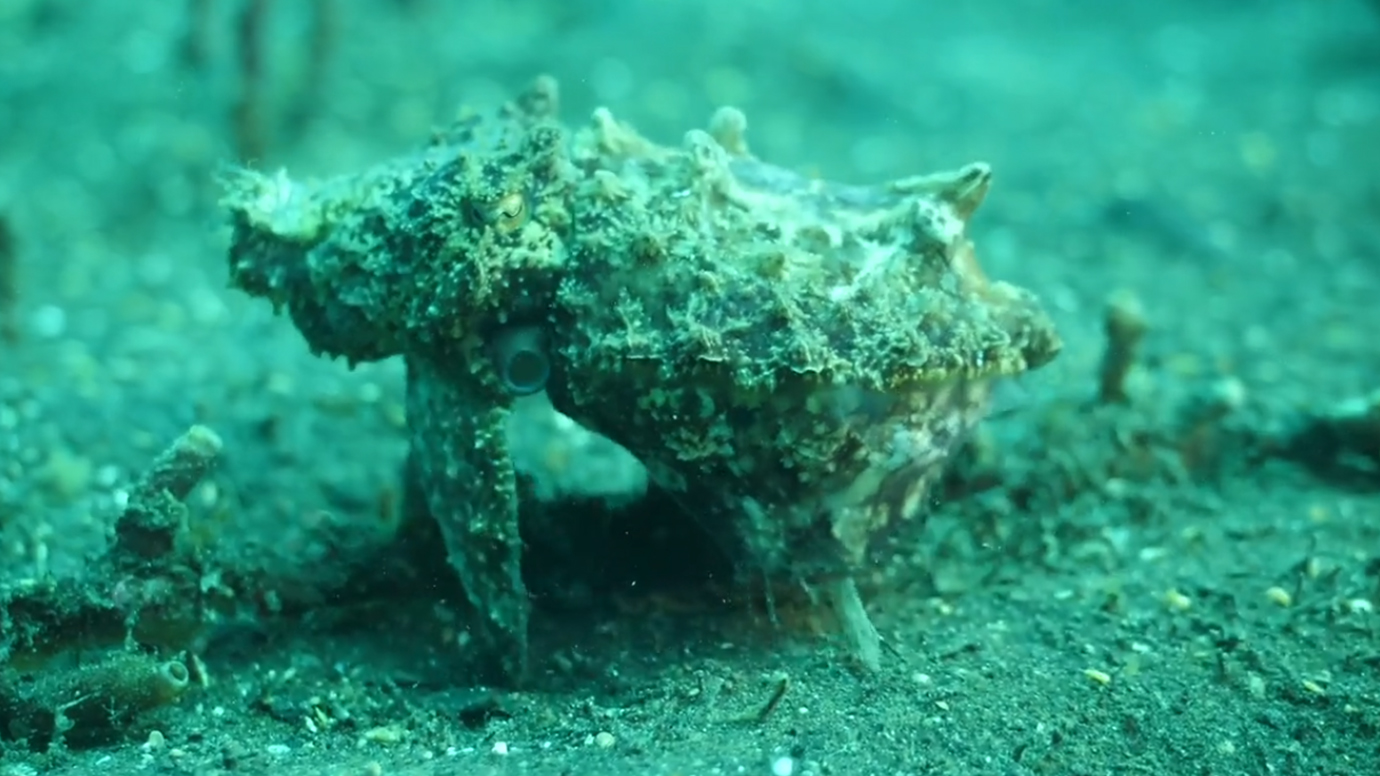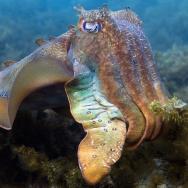The flashy flamboyant cuttlefish is among the most famous of the cephalopods—but it is widely misunderstood by its legions of fans.
A new paper from the Roger Hanlon laboratory at the Marine Biological Laboratory sets the record straight.
“This animal is well known in the internet community, has been on TV many times, and is popular in public aquariums,” said Hanlon, a leading expert on camouflage in cephalopods. “In almost all cases, (its skin) is showing this brilliantly colorful flamboyant display.”
But Hanlon’s field studies in Indonesia, reported in his latest study, tell a different and richer story. “It turns out in nature, flamboyant cuttlefish are camouflaged nearly all of the time,” he said. “They are nearly impossible to find.”
In the blink of an eye, this type of cuttlefish can switch from some of “best camouflage known in the cephalopods” to their dazzling flamboyant display. But they only use this display on certain occasions: For elaborate male courtship rituals; or when males are fighting over a female; or to flash briefly at a threatening object when it approaches too close, presumably to scare it away.
“The flamboyant display is common when a diver approaches close enough to photograph, which is why the public may think this species always looks so colorful,” said Hanlon, a senior scientist at UChicago-affiliated MBL. “But it is rare to see this species in flamboyant display in the wild.”
A flamboyant courtship
The courtship displays by male flamboyant cuttlefish (Metasepia pfefferi) are among the most elaborate of all cephalopods. This study reveals new observations about the sex life of the flamboyant cuttlefish—from courtship to mating to egg laying—gleaned from hours of video taken during many SCUBA dives in Indonesia with teams of volunteers.
Males, which tend to be significantly smaller than females, approach and court a camouflaged female with flamboyant displays and elaborate rituals, which include “waves” (rapidly waving three pairs of arms while displaying “passing cloud”) and “kisses” (male darts forward and briefly, gently touches his arms to hers).
Females generally ignore males while they are courting; they stay camouflaged and motionless or just keep on foraging and hunting. Male courtship goes on non-stop for prolonged periods (6 to 52 minutes observed in this study).
In three observations, two males competed simultaneously for a female. Males can display flamboyant courtship signaling on one side of the body while flashing white (signaling aggression) on the other side toward the rival male.
In one case, male competition ended abruptly when one of the males, while facing the female and waving and kissing, backed into a camouflaged scorpionfish and was eaten. “Sex can have a real cost,” Hanlon noted.
Females were choosy and often rejected courting males. Female receptivity was obvious when she widely spread her first three pairs of arms (while standing on the fourth pair of arms). The male would then swim within the arm crown and quickly deposit spermatophores in the buccal region where the seminal receptacle is located. Average duration of mating was only 2.89 seconds.
After fertilization, the successful male guarded the female for a while but not, curiously, up to egg laying, as is common with other cuttlefish. When another male was present, mate guarding was aggressive.
“The flamboyant display is common when a diver approaches close enough to photograph, which is why the public may think this species always looks so colorful.”
The female lays her eggs while camouflaged and staying still. She then pushes her eggs under a coconut shell and affixes them to the inside of the shell. When the hatchlings exit the egg case and jet away, they are fully formed and capable of camouflage and signaling.
Defense mechanism
The primary mode of defense for both male and female Metasepia pfefferi is camouflage, and they remain camouflaged almost all the time. If a predator or threatening object (such as a diver) comes too close, though, the cuttlefish will flash the flamboyant display—switching from camouflaged to flamboyant in 700 milliseconds.
The vibrant colors (white, yellow, red and brown) of the flamboyant display are combined with apparent “waves” of dark brown color that produce a dazzling and dizzying kaleidoscope of motion, color and patterning. The fast neural control of many thousands of chromatophore organs in the skin enable this unique signaling capability—all turned on or off in less than a second, and changed depending on the behavioral context of the courtship, or in the case of defense, the fish predators that discover them.
“Birds are renowned for highly evolved visual displays that depend partly on dramatic postural changes (with wings of different color and pattern, in particular), yet this invertebrate cuttlefish species has evolved equally dramatic and complex displays mainly with its skin coloration,” Hanlon said.
Hanlon is a senior scientist in the MBL’s Eugene Bell Center for Regenerative Biology and Tissue Engineering.
Citation: “Flamboyant cuttlefish behavior: Camouflage tactics and complex colorful reproductive behavior assessed during field studies at Lembeh Strait, Indonesia,” Hanlon and McManus, Journal of Experimental Marine Biology and Ecology, August 2020. DOI: 10.1016/j.jembe.2020.151397
—This story was first published by the Marine Biological Laboratory.











